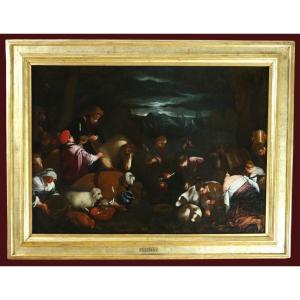Original canvas on original stretcher measuring 73.5 cm by 59.5 cm
Period and Louis XIV style frame of 91 cm by 80 cm
This superb portrait reminds us if necessary that Tocqué was trained by Nattier and that he is worthy of the training received from his mentor. One of the characteristics of Nattier's painting is his delicate touch, the evanescence of which melts the line until it disappears. We find this Art completely in the smile of this young woman and more broadly in her entire face. When it comes to style, there is once again no doubt about the Master's imprint on his student. Nattier in the 1730s/1740s represents women surrounded by a large coat which most often covers the left shoulder then descends down the back towards the middle of the opposite arm. Tocqué for the anecdote chooses the opposite direction! The other important difference lies in the dress here decorated with patterns while Nattier chooses dresses in plain colors, white, light gray and especially blue (often called Nattier blue). The lineage is therefore strong in this superb portrait of very high quality.
Louis Tocqué (1696-1772).
He is a student of Nicolas Bertin and Jean Marc Nattier. Approved by the Academy in 1731, he became a full member in 1734 by presenting the portraits of Galloche and the sculptor Jean Louis Lemoine. (Now in the Louvre). In 1739, he painted the portrait of the great dolphin and then of Queen Marie Leczinska (Paris, Louvre museum). the portrait of Marie Leczinska is the painter's centerpiece, the queen full-length and standing, her body turned slightly to the left, her head facing, the right hand pointing to the royal crown placed on a gilded console; the dress is white satin flowered with red poppies, green foliage and gold. “With a supple and powerful coloring which excludes neither strength nor softness, it has an air of amiable majesty, of smiling authority which makes this painting of the most incontestable merit. » His reputation is great, he is called to the court of Russia by the Empress Elisabeth and stays there two years before passing through the court of Denmark in 1759 and in fact, staying in all the courts of Northern Europe where he received a royal welcome in every sense of the word. From 1737 to 1759, he exhibited numerous works at the Academy exhibitions. His touch is recognizable in the details. The representation of the corners of the lips is an example. As for the more general style of his painting we find a search for truth and naturalness in the representation of attitudes... this search which could be described as modern is such that he even refused the Empress Elisabeth of Russia to modify his very unsightly nose! Louis Tocqué is exhibited in many museums around the world.










































 Le Magazine de PROANTIC
Le Magazine de PROANTIC TRÉSORS Magazine
TRÉSORS Magazine Rivista Artiquariato
Rivista Artiquariato